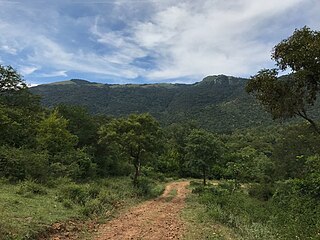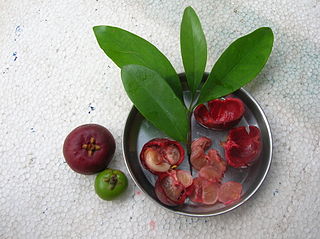
The Western Ghats, also known as the Sahyadri, is a mountain range that stretches 1,600 km (990 mi) along the western coast of the Indian peninsula. Covering an area of 160,000 km2 (62,000 sq mi), it traverses the states of Gujarat, Maharashtra, Goa, Karnataka, Kerala, and Tamil Nadu. The range forms an almost continuous chain of mountains along the western edge of the Deccan Plateau, from the Tapti River to Swamithoppe in Kanyakumari district at the southern tip of the Indian peninsula. The Western Ghats meet with the Eastern Ghats at Nilgiris before continuing south.

The purple frog, Indian purple frog, or pignose frog is a frog species of the genus Nasikabatrachus. It is endemic to the Western Ghats in India. Although the adult frog was formally described in October 2003, the juvenile form of the species was described earlier in 1917.
The Eastern Ghats is a mountain range that stretches 1,750 km (1,090 mi) along the eastern coast of the Indian peninsula. Covering an area of 75,000 km2 (29,000 sq mi), it traverses the states of Odisha, Telangana, Andhra Pradesh, Karnataka, and Tamil Nadu. The range forms a discontinuous chain of mountains along the eastern edge of the Deccan Plateau, stretching from north of the Mahanadi River in Odisha to Vaigai River in Tamil Nadu at the southern end of the Indian peninsula. The Eastern Ghats meet with the Western Ghats at Nilgiris. The average elevation is around 600 m (2,000 ft) and Arma Konda is the highest peak in the mountains at 1,680 m (5,510 ft).

The Denison barb, Denison's barb, Miss Kerala, red-line torpedo barb, or roseline shark is an endangered species of cyprinid fish endemic to the fast-flowing hill streams and rivers of the Western Ghats in India. It is commonly seen in the aquarium trade; pet collection caused it to become endangered and is its single major threat.

The Biligirirangana Hills or Biligirirangan Hills is a hill range situated in Chamarajanagar District in south-western Karnataka, at its border with Tamil Nadu in South India. The area is called Biligiri Ranganatha Swamy Temple Wildlife Sanctuary or simply BRT Wildlife Sanctuary. It is a protected reserve under the Wildlife Protection Act of 1972. Being close to the Eastern Ghats as well as the Western Ghats, the sanctuary has floral and faunal associations with both regions. The site was declared a tiger reserve in January 2011 by the Government of Karnataka, a few months after approval from India's National Tiger Conservation Authority.

Sharāvati is a river which originates and flows entirely within the state of Karnataka in India. It is one of the few westward flowing rivers of India and a major part of the river basin lies in the Western Ghats. The famous Jog Falls, located about 25 km from Siddapura, is formed by this river. The river itself and the regions around it are rich in biodiversity and are home to many rare species of flora and fauna.
Sunder Lal Hora was an Indian ichthyologist known for his biogeographic theory on the affinities of Western Ghats and Indomalayan fish forms.

The Thamirabarani or Tamraparni or Porunai is a perennial river that originates from the Agastyarkoodam peak of Pothigai hills of the Western Ghats, above Papanasam in the Ambasamudram taluk. It flows through Tirunelveli and Thoothukudi districts of the Tamil Nadu state of southern India into the Gulf of Mannar. It was called the Tamraparni River in the pre-classical period, a name it lent to the island of Sri Lanka. The old Tamil name of the river is Porunai. From the source to sea, the river is about 128 kilometres (80 mi) long and is the only perennial river in Tamil Nadu. This river flows towards north direction initially. However, it changes to east direction later.

Chalakudy River or Chalakudy Puzha is the fifth longest river in Kerala, India. The river flows through Thrissur district, Palakkad district and Ernakulam district of Kerala. The total drainage area of the river is 1704 km2. Out of this, 1404 km2 lies in Kerala and the rest in Tamil Nadu. The length of the river is 145.5 km. Though Chalakudy River in strict geological sense is a tributary of the Periyar river, for all practical purposes it is treated as a separate river by Government and other agencies. The river has gained its name since it flows along the banks of the Chalakudy Town, the major settlement along the course of the river. It is perhaps the most unpolluted and pristine river in the state and even in India due to the limited amount of industries and wastage disposal around it. Chalakudy River and its basin area were one of the most affected rivers during the 2018 Kerala floods.

Bisle is a small village in the heart of south-western India's Western Ghats. The village is located in Hassan District's Sakleshpur (Sakaleshpura) Taluk.

Chinnar Wildlife Sanctuary is located 18 km north of Marayoor on State Highway 17 in the Marayoor and Kanthalloor panchayats of Devikulam taluk in the Idukki district of India's Kerala state. It is one of 18 wildlife sanctuaries among the protected areas of Kerala.

Oreichthys cosuatis is a small cyprinid fish found in India and Bangladesh.In India it is found along the ganga and brahmaputra river drainage in the states of West bengal and odisha It is also reported from Thailand and Myanmar.

Oreichthys crenuchoides is a small cyprinid found in Assam, India. It is imported for the aquarium trade under the name neon highfin barb or high-fin variable barb. It is an atypical Oreichthys in that the face is more rounded than in O. cosuatis and other Oreichthys species.

Oreichthys is a genus of tropical barbs found in Thailand, India, Bangladesh, Myanmar (Burma), northern Malay Peninsula, and the Mekong basin in Laos. They are found in ditches, ponds, streams and canals. The genus Oreichthys was originally established to receive little fish collected in a small brook on Kao Sabap, an extensive mountain range near Chantaban, Thailand.

Hypselobarbus is a genus of fish in the family Cyprinidae endemic to India.
Karian Shola National Park is a protected area in the Western Ghats, India, nominated as a national park in 1989. The Western Ghats are a chain of mountains running down the west of India parallel with the coast some 30 to 50 km inland. They are not true mountains, but the edge of a fault that resulted about 150 million years ago as the subcontinent of India split from Gondwanaland. They are older than the Himalayan mountain range and are clothed in ancient forests. They influence the weather in India as they intercept the incoming monsoon storm systems. The greatest rainfall occurs between June and September during the southwest monsoon, with lesser amounts falling in the northeast monsoon between October and November. The Western Ghats are a UNESCO World Heritage Site and are considered to be one of the eight most important "hotspots" of biological diversity in the world.

Garcinia indica, a plant in the mangosteen family (Clusiaceae), commonly known as kokum, is a fruit-bearing tree that has culinary, pharmaceutical, and industrial uses. It grows primarily in India's Western Ghats: in the states of Maharashtra, Goa, Karnataka and Kerala. It is considered as an endemic species to the Western Ghats and forests in India.
Oreichthys duospilus is a species of freshwater ray-finned fish belonging to the family Cyprinidae, the family which includes the carps, barbs and related fishes. This fish is endemic to India where it is found in the darianges of the Krishna and Sharavati rivers in the states of Maharashtra and Karnataka. This species has a maximum standard length of 3.1 cm (1.2 in).

Rajeev Raghavan is a fisheries scientist and aquatic conservation biologist known for his work on the freshwater fishes of the Indian subcontinent. Rajeev is currently an Assistant Professor at the Kerala University of Fisheries and Ocean Studies, Kochi, India, the South Asia Chair of the IUCN’s Freshwater Fish Specialist Group., and the IUCN Freshwater Fish Red List Authority Coordinator for Asia and Oceania.
Shishila is a village located at the base of Western Ghats in Belthangady taluk of the Karnataka State, India. The main attraction of the village is a temple dedicated to Lord Shishileshwara.













